3 Volumes
Culture: The Flavors of Philadelphia Life
Philadelphia began as a religious colony, a utopia if you will. But all religions were welcome, so Quakerism mainly persists in its effects on others, both locally and in America, in Art, clubs, and the way of life.
History: Philadelphia and the Quaker Colonies
Philadelphia and the Quaker Colonies
Reconstruction and the Winning of the West
Huge vacant land distracted attention from the wounds of the Civil War, but black people failed to move from their problems.
Japan and Philadelphia
Philadelphia and Japan have had a special friendship for 150 years.
Madame Butterfly (2)
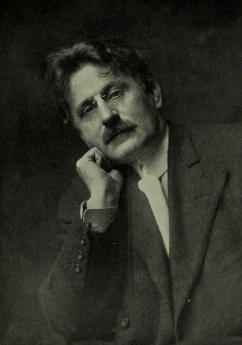
|
| John Luther Long |
There are two ways of looking at the love affair of Pinkerton, the dashing Philadelphia naval officer, and Madame Butterfly, the beautiful Japanese geisha. John Luther Long wrote about it one way, while Puccini somehow portrays it differently, even though Long collaborated on the Libretto of the opera. Puccini, of course, was himself a famous libertine, tending to follow the typical belief of such men that women somehow enjoy being victimized. Long in real life was a Philadelphia lawyer, trained to keep a straight face when people relate what messes they have got into. If you know the story, you can see Long in the person of Sharpless, the consul. Sharpless is definitely meant to be a Philadelphia name.
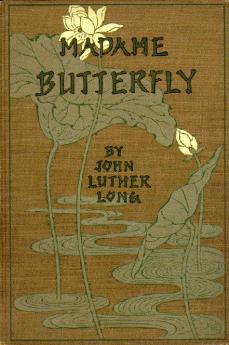
|
| Madame Butterfly |
Long was one of the early members of the Franklin Inn, and it is related he wrote much of his successful play at the tables of the club on Camac Street. David Belasco was the "play doctor" who knew how to make a good story fill theater seats. Even after Belasco's polishing, the play came through as a portrayal of the well-born gentleman who had been trained to regard foreign girls as just what you do when you are away from home. His real girlfriend, the beautiful Philadelphia aristocratic woman in a spotless white dress, was the sort you expected to marry. In just a few sentences of Long's play, this woman comes through as just about as distastefully aloof to foreign women as it is possible to be while remaining rigidly polite about it. Butterfly sees this at a glance, knows it for what it is, and knows it is her death. Her duty immediately is "To die honorably, when one can no longer live with honor".
It is Puccini's genius to take this story of how two nasty Americans destroy an honorable Japanese girl and using that same story with the same words, make it into a romantic woman being destroyed by a hopeless, helpless love affair. The power of the music overwhelms the story and sweeps you along to the ending. Even if you feel like Long/Sharpless, dismayed and disheartened by watching some close acquaintances doing things you know they shouldn't.
When Puccini's opera comes to Philadelphia every year or so, the Franklin Inn has a party for the cast, one of the great events of the Philadelphia intellectual scene. Somehow, the full intent of Luther Long's work never seems to come out.
As told by one of his fellow interns who is now a very old man, Kitamura was one of the best interns the Pennsylvania Hospital ever had; diligent, dependable, intelligent and infinitely polite. He married one of the hospital's nurses, and they tended to keep to themselves, especially in 1941, as war clouds began to gather. About two months before Pearl Harbor, both of them mysteriously disappeared. Kimura's wife later wrote one of her friends that they were in Japan. After the war, it was learned that she had been placed in a concentration camp as an enemy alien, and when released, had divorced him.
Still later, it was learned that Kimura had a distinguished medical career in Japan. He kept up a minimal sort of correspondence with his old intern pals, inviting them to visit if they were ever in Japan.
In 1985 one of them did so, going to the largest hospital in Tokyo to inquire. Great silence ensued; unfortunately, the revered and distinguished physician had recently died. You knew, of course, that he was the Emperor's personal physician.
Philadelphia and Japan
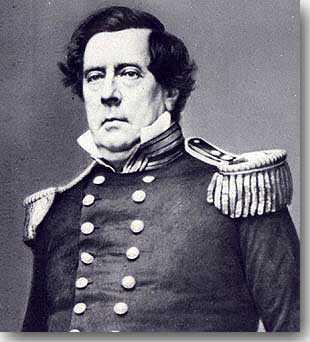
|
| Commodore Matthew Perry |
There may have been earlier contacts, but the strong relationship between Philadelphia and Japan seems to trace mainly to the 1876 Centennial Exhibition here when the awakening Japanese decided to introduce themselves to Western peoples. Japan closed itself off from the rest of the world in 1600, and Matthew Perry opened them up in 1854 by shocking them with a display of how far Western culture had pulled ahead of them. When they saw the black smoke coming out of the smokestacks of the steam battleships, and particularly when they saw all those big guns could destroy a town whose own guns could not reach them, the Japanese military government saw it had to do something drastic.
Matthew Perry, the Commodore, was Oliver Hazard Perry's younger brother and a career naval officer. It is very likely he suggested a Japanese overture to President Millard Fillmore, whose brief presidency was mostly occupied with trying to compromise his way out the coming Civil War in America. Reacting to a mixture of just enough implied force, and just enough understatement, the Japanese agreed to let American whaling ships refuel and resupply in Japan, to be hospitable to American shipwrecks, and to allow more unspecified landings. As the Japanese tell it, the Emperor had been displaced by the Shogun for several centuries and was restored to power in 1867. Essentially, forces pressing for westernization and trade had pushed aside more militaristic feudalism under the Samurai. By 1876, they were ready to show the world how far they had come.
Inflating and Deflating Japan.
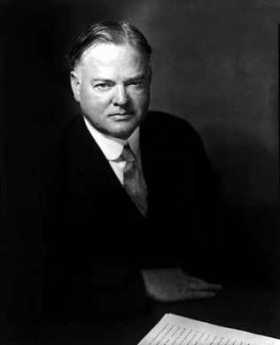
|
| Herbert Hoover |
Survivors of the Great World Depression of the Thirties need no convincing about the catastrophe of deflation, but even they would have trouble defining it. Deflation is, well, something that was caused by the 1929 stock market crash, or maybe it was Herbert Hoover's fault, or maybe Hitler's fault. It is enough to know it was bad, that it's all over, and that it is on page six of the newspapers, below the fold. Unfortunately, it has returned again to crush the poor Japanese for the past fifteen years, but still, no one seems willing to say what causes deflation, or what will cure it. So, let's venture.
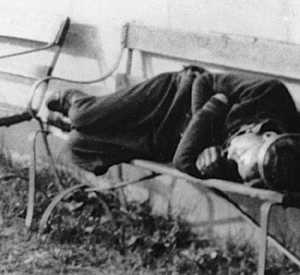
|
| World Depression |
The world acts as though it believes the following one-liner: The main cause of deflation is inflation. Merely keep inflation under control, and you will then avoid deflation, as well as the awkward need to know what to do about it. The main proof of this fragile argument lies in the fact that America has somehow avoided serious recession for almost twenty years by relying on "inflation targeting". It's a little uncomfortable to notice that the main proof that inflation is the only cause of deflation rests on the fact that we have had no recessions during the time we had no inflation. When central bankers are confronted with the lack of logic in that position, they appear distinctly uncomfortable. It may be correct that only inflation can cause deflation, but the proofs are unsatisfying.

|
| Rock, Paper, Scissors |
So let's retreat to a little safer ground. Let's say that massive shifts of currency can topple the stability of any government or national economy; inflation is the main cause of massive currency movements. However, it's like the old children's game of paper, rock, and scissors; you can't be sure in advance whether you want diversification, strength, or flexibility. Stability rests on long term financial commitments, like long-term bonds, or mortgages, insurance, or pension schemes. But maybe you don't want strength, you might want agility. Then, if you are in a position to anticipate currency disruption, you will shift from long-term to short-term. Panic like that undermines the people who are locked to thirty-year commitments but may not have thirty years to ride them out. The value of a national currency is tied to shifts in interest rates; that's the same thing, one within borders and the other across borders, like pushing on a balloon.

|
| cameras |
If you think government action can rescue a real panic, look at Japan. The Japanese sold good cars and cameras, acquiring a lot of foreign currency. That should have caused their own currency to increase in value, but instead, the Japanese just printed more of it to maintain the low international price of cars and cameras. All that resulting loose cash, confined within their borders, caused serious inflation of Japanese real estate and stock market prices; when this inflation shifted around, it capsized their boat. Long-term debts defaulted, eventually bringing the banks down with them.
Perhaps the Chinese have learned a lesson from Japan's experience, but don't count on it.
Inazo Nitobe, Quaker Samurai
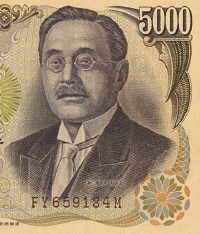
|
| Inazo Nitobe |
The story of Inazo Nitobe (1862-1933) comes in two forms, one from the Philadelphia Quaker community, and the other from his home, in Japan. One day in Philadelphia, a well-known ninety-year-old Quaker gentleman, rumpled black suit, very soft voice -- and all -- happened to remark that his Aunt had married a Samurai. A real one? Topknot, kimono, long curved sword, and all? Yup. Uh-huh.
That would have been Inazo Nitobe, who met and married Moriko, nee Elizabeth Elkinton, while in college in Philadelphia. He became a Quaker, and when the couple returned to Japan, the Emperor then found himself confronted with a warrior nobleman who was a pacifist. You can next perceive the hand of his Quaker wife in the deferential diplomatic suggestion that there were vacancies for Japan at the League of Nations and the Peace Palace in the Hague. Perhaps, well perhaps, there could be service to his Emperor as well as his new religion in such an appointment for her new husband. Good thinking, let it be done. As far as Philadelphia is concerned, Ambassador Nitobe next appeared when Japan was invading Manchuria. The Emperor had sent Nitobe on a tour of America to explain things. At the meetinghouse then on Twelfth Street, Nitobe adopted the line that Japan was only bringing peace and order to a chaotic barbarian situation, actually saving many lives and restoring quiet. After a minute of silence, Rufus Jones rose from his seat on the "facing bench": He was having none of it. And that was that for Nitobe in Philadelphia.
The other side of this story quickly appears if you go to Japan and ask some acquaintances if they happen to have heard the name Inazo Nitobe. That turns out to be equivalent to asking some random American if he has ever heard of Abraham Lincoln. To begin with, Nitobe's picture appears on the 5000 Yen ($50) bills in everybody's pocket. He was the founder of the University of Tokyo, admission to which now is an automatic ticket to Japanese success. He wrote a number of books that are now required reading for any educated Japanese. A number of museums, hospitals, and gardens are named after him; one of them outside Vancouver, at the University of British Columbia.
Nitobe's father, Jujiro Nitobe, had been the best friend of the last Shogun, deposed by the return of the Emperor to effective control after Perry opened up Japan to Western ideas. The Shogun was beheaded, of course, and the tradition was that the victim could ask his best friend to do the job because he would do it swiftly. Jujiro was unable to bring himself to the task, refused, and his family was accordingly reduced to poverty. Subsequently, the Samurai were disbanded by the newly empowered Emperor, given a pension, and told to look for peaceful work. Inazo Nitobe was in law school when the Emperor's emissary came and said that Japan did not need culture, it had plenty of culture. The law students would please go to engineering school, where they could help Japan westernize.
Nitobe later wrote a perfectly charming memoir, called Reminiscences of Childhood in the Early days of Modern Japan , which dramatizes in just a few pages just how wide the cultural gap was. For example, Nitobe's father brought home a spoon one day, and this curious memento of how Westerners eat was placed in a position of high honor. One day, a neighbor ordered a suit of western clothes, and hobbled around it, saying he did not understand how Westerners are able to walk in such clothes. He had the pants on backward.
One of Nitobe's greatest achievements was to struggle with his appointment as Governor of Formosa (Taiwan). Japan acquired this primitive island in 1895, and Nitobe got the uncomfortable role of colonist in Japan's first experience with colonization. He sincerely believed it was possible for Japan to bring the benefits of Westernization to another Asian backwater, but just as the British found in their colonies, there was precious little gratitude for it. Although he was undoubtedly acting dutifully on the Emperor's orders when he later came to Twelfth Street Meeting, he surely knew -- perhaps even better than Rufus Jones -- that there was something to be said on both sides, no matter how conflicted you had to be if you were in a position of responsibility. This most revered man in his whole nation almost surely saw he had been a complete failure in Philadelphia.
AFSC: American Friends Service Committee
Two things uniquely characterize the work of the Friends Service Committee (AFSC): it's often both dangerous and unpopular. That's not required for relief following Indonesian tidal waves perhaps, but the work that really needs someone to do is often both dangerous and controversial.
The Service Committee was founded in 1917, mostly by Rufus Jones and Henry Cadbury, as a way of helping conscientious objectors to World War I. The Mennonites, the Brethren, and the Quakers were opposed to all wars, not just that particular one, but two of those religions are of German ancestry, and lacked the same credibility of the English-origin Quakers in a war with English allies against the Huns, Boche, and Kaiser enemies. The early focus of the Committee was on the Field Service, or Ambulance Corps; which was plenty close to the action, and plenty dangerous. After the War, the defeated German population was starving, and the Quaker Herbert Hoover directed the relief effort with great credit to the Quaker name, and immense European gratitude.
After that, when German Jews were suffering persecution by the Hitler administration, the Quakers initially responded in a uniquely Quaker way. Rufus Jones and two other Quakers went to see Reinhard Heydrich, to tell him the world disapproved of his behavior. They fully realized they represented a pool of important world opinion, particularly within Germany, and it was time to speak truth to Power. The Germans left the room to confer, and the three Quakers bowed their heads in silent prayer. Apparently, the room was tape recorded, and when the German officials returned, they did promise some efforts to improve matters. As the situation for the Jews soon got much worse, many Quakers risked a great deal to shelter and rescue the persecuted exiles. Relief to the defeated German populace had to be repeated after that war, as well. Each effort built up more credibility to be able to switch sides for the next effort, and the sincerity has seldom been seriously questioned.
The Japanese were also our hated enemies in World War II, and once more a long history helped the relief effort. Nearly 100,000 American citizens of Japanese origin were interned on the West Coast as potential traitors in 1941, often under deplorable conditions. Clarence Pickett was a director of AFSC at the time, and his sister had spent years in Japan as a missionary, so his remonstrations with the American government were prompt and credible. One of the more active workers was Esther Rhoads, sister of the famous surgeon, who had spent time in Japan earlier. One of the ingenious efforts with the Nisei was to assist 4,000 of them to get into college and find them hostels and jobs while they were away at school. Many of these college students later became prominent in various ways, greatly assisting the post-war reconciliation between the two countries.
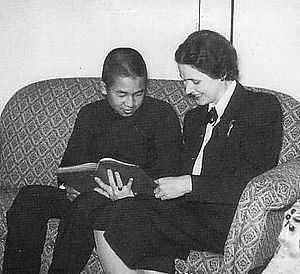
|
| Prince Akihito and Elizabeth Gray Vining |
Two Quaker ladies at the AFSC made a totally unique contribution when a request was received to provide a suitable tutor for the Crown Prince, now Emperor. He didn't convert to Christianity, but he later married a Christian, and you can be sure he got a plenty good dose of Quaker style and belief from Elizabeth Gray Vining. This tall, strikingly handsome Philadelphia woman had Bryn Mawr written all over her and turned heads whenever she entered a room. When she went back home, she was followed as a tutor for seven years by, guess who, Esther Rhoads who by then was the director of the Tokyo girls school. It remains to be seen, of course, what the final outcome of this deeply emotional situation will prove to have been. At the moment, the main sufferer seems to be the immensely talented American-educated woman who married the Emperor. But we will see; these are all powerful women in a very quiet way, unaccustomed to losing. One wishes the royal family all the best in their sometimes difficult position.
And then the Service Committee did its work in Vietnam, in Iraq, in Zimbabwe, and Somalia on the unpopular side, in every case. There are stories of venturing into war zones with hundred-dollar bills scotch-taped to their torso, where every fifty feet there was someone who would cut your throat for a dime. One worker in Laos entertained a group of us tourists with tales of living for weeks with nothing to eat but grasshoppers and cockroaches. Dangerous, unpopular, and uncomfortable. It sounds like a wonderful outlet for someone who is a perpetual rebel without a cause, but if you can find one of those at the Service Committee, you must have done a lot of looking.
The Service Committee, like the Quaker school system, is mostly run by non-Quaker staff. That means that neither of them exactly speaks for the religion itself. This little religious group of 12,000 members is stretched thin to provide a vastly greater world influence than its numbers imply. Hidden in the secrets of the group is an enduring ability to attract sincere non-member adherents to their work. And a quiet watchfulness to avoid losing control to any wandering rebels without a cause.
REFERENCES
| Window for the Crown Prince: Akihito of Japan, Elizabeth Gray Vining ISBN-13: 978-0804816045 | Amazon |
Philadelphia in 1876: The Centennial
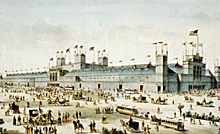
|
| The Centennial Exhibition |
The Centennial Exhibition could easily claim to be the most transforming event that ever happened to our town. It represented the hundredth year of our independence, although 1887 would be the hundredth anniversary of our nation, and anyway, the Declaration of Independence was just sort of a hook to hang the exhibition on. Opened in the spring with a speech by the Civil War victor, Ulysses S. Grant, it was also closed in the fall with another speech by him. The planning, design, and atmosphere of the whole thing was triumphalism -- the world will never be the same because this country has arrived. The exhibition introduced to an awe-struck world, the electric light bulb, the typewriter, and the telephone. We've won the Civil War, and this is how we won it. It's too bad of course that we had to tousle up the South that way, but look at how great it is going to be to participate in the Colossus of Tomorrow.
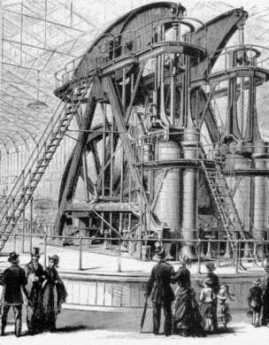
|
| Corliss Steam Engine. |
The civilized world competed with each other to display their things of pride in national pavilions. And next to them was even bigger pavilions by the States, with even more matters of pride to display. The main exhibition hall covered twenty-one acres. The future was here, and it was machinery. Machinery Hall was filled with thousands of machines of one sort or another, and wonder of wonders, they were all driven by one operator controlling a single huge engine, the Corliss Steam Engine. The Age of Artisans and Craftsmen was over. We had entered the world of Industrialism.
It was intended that the rest of the world should take notice of America, and of course of America's bumper City. Less noticed was that Philadelphia woke up to the rest of the world. Over eight million people attended the exhibition, most of them Americans. A great many Philadelphians spent a whole week poring over the exhibits, and some even spent a whole month doing it. Just as Japan got the jolt of its life when Commodore Peary showed them just how far-out-of-it-all they were, Philadelphia got the same jolt from the European exhibitors at the Centennial. We were showing off, but we were learning.
West Fairmount Park
Fairmount Park is considerably larger on the west bank of the Schuylkill than on the east, and the points of interest are somewhat more diluted by woods and pasture. Partly, that is a consequence of being the site of the 1876 Centennial Exhibition , and partly that urban growth had not encroached so much into the farmland at the time the park was created. On the west bank at the time of the Revolution, there were still 300-400 acre farms, whereas the east bank farms had been cut up into gentleman's
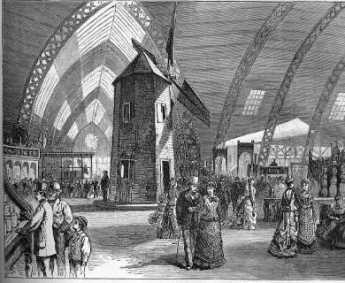
|
| Centennial Exhibition |
estates. The Schuylkill takes two 90-degree turns within the Park limits, leaving a point of high land on either side of the river. On the east side, the East Park reservoir is at the apex, and on the west side, the dominant point is Belmont Mansion. For a while, there was a restaurant at Belmont, but at the moment it's a pity but little advantage is taken of a very scenic view. Two judges once lived in the mansion, William Peters, and his nephew Richard Peters. William was a Tory and had to flee to England. Richard made a better guess and as a rebel, therefore could live on in scenic splendor.
For orientation, the West Park mansions extend in an arc from The Solitude in the south to Chamonix in the north. For the moment limiting our list to houses present when the Park was created, there is Sweetbrier, The Pig-Eye Cottage, Belmont, Ridgeland, Greenland, and the Lilacs. The last three houses belonged to three well-known Philadelphia families, Garrett, J.B. Lippincott, and Walnut, who established themselves in 19th Century commerce rather than 18th Century politics. Sweetbrier was one of those centers of French Philadelphia, when Samuel Breck continued his father's close relationship developed as the fiscal representative of French Forces in America, entertaining LaFayette and other such friends of the new Republic. The Pig-eye cottage is used by the Park administration, and closely resembles the Caleb Pusey house, but otherwise has no remarkable history. Solitude, on the other hand, really was the retreat for John, then Richard, then Granville. John Penn entertained George Washington here while he was presiding over the Constitutional Convention.
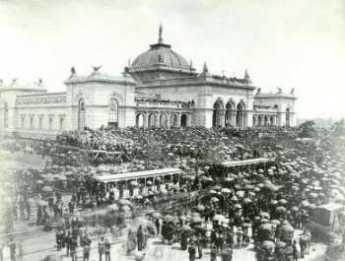
|
| fair |
Fairmount Park is notable for some buildings which are unfortunately no longer there, and some other buildings that were transplanted there. The East Park is a historical monument, while the West Park is more a house museum. Governor Mifflin's house is gone from the Falls area, Powelton is gone, and Lansdowne the estate where the Proprietor John Penn was seized by rebel soldiers. His family was later paid less than a penny an acre for the 21 million acres of Pennsylvania land they clearly owned. Sedgley is also gone, and all of these places have a place in history. On the other hand, it is well to remember that all of the industrial slums along the river were cleared away to be replaced by the charm of Boat House Row.
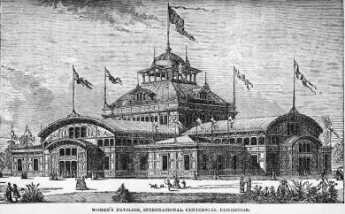
|
| Exhibition |
It keeps being repeated that Fairmount Park is the largest urban park in America, but the fact is it is bigger than the city can afford to maintain, just as a monument to the colonial style of life. It was a grand place to have a World's Fair in 1876, and Memorial Hall remains, along with the Japanese pavilion, a truly priceless reproduction of Japan under the Shogun. Fairmount Park has the first Zoo in America, still a place of note in zoological circles, and many ballparks, summer music halls, and other modern recreational attractions. It contains Cedar Grove, a splendid Quaker homestead in Welsh style, transported from its original location in Frankford. The Letitia Street House was too fine an example of 17th Century urban architecture to lose, so it was moved to the Park from Letitia Street, approximately 2nd and Market Streets. William Penn lived for a while on Letitia Street, named after his daughter, but it is not entirely clear who lived in this particular little house. There doesn't seem to be anything you can do about people calling it the William Penn House.
Fairmount Park is the largest urban park. It doesn't have roley coasters, but we don't miss them, and it doesn't have Mickey Mouse, at least so far. There is absolutely nothing like it anywhere. Anyway even if there were, Philadelphians wouldn't notice.
Paying Bills Electronically

|
| Commodore Matthew Perry |
Commodore Perry "opened up" Japan in 1854, but Ronald Reagan opened up the banks and finances of that country more than a century later. Because his chief of staff Don Regan had been in charge of Merrill Lynch, the Japanese let that company in, and because of some favors by J. P. Morgan in the 19th Century, they also admitted Morgan Stanley. Although several Japanese banks had grown to be the largest in the world, the Japanese never adopted the popular American habit of personal checking accounts. One of the surprised observations of the new American pioneers was that a bank could be pretty successful, without all that expensive nuisance of processing checks. Twenty years later, American banks are starting the long and difficult job of weaning their customers away from paper checks.
There's even a personal story of an early American expatriate sent to work in Tokyo for Morgan Stanley, taking his shirts to be ironed by the local Japanese laundryman whose English was poor. Each time he collected his shirts, the American would pull out a blank check, signed with a flourish, accepted with much bowing and murmuring of delight. After several months, an English-speaking Japanese was summoned to one of these ceremonies, and the expiate was politely asked what he was planning to do about paying his bill. His highly venerated checks were all neatly stored in a lacquered box under the counter but had never been taken to the bank.
Americans are now engaged in a frenzy of using credit cards. Something has to change in that system, which is proving to be a very expensive substitute for checks since it amounts to giving short-term loans to and from a lot of people who don't need, and didn't ask for, a loan. Given an open choice of paying the invisible extra cost of using a plastic card, or just waiting until the end of the month to complete the transaction, most sensible people would prefer to wait. The plastic card system just can't continue in its present form, and one possible substitute is to use a personal computer to pay bills electronically. That's a step better than using plastic, but as we will describe, it needs to become two steps better before it is really satisfactory.
To do electronic bill-paying you, of course, need to have a computer, and you have to go through the laborious process of entering a lot of information about each person who is going to get paid. Once that is done, and security precautions established, paying bills is a much simpler task than it used to be. The helpless consumer even has the occasional experience of finding that some creditor billed him twice, or inaccurately; my computer caught your computer making a mistake. It now hard for me to imagine going back to paper checks and bank stubs.
However, I've become spoiled and demanding. There are four deficiencies in this system which irritate me enough to bring me to an open bidding process ill switch my accounts to any bank that fixes them.
1. Invoice memo entry. The entry screen you use when you prepare a check should contain a block to enter some kind of notation, such as the biller's invoice number. When that block is completed, the material should be printed on the check. The memo might say "Girl Scout Cookies", or "Hedge trimming", or "Invoice # 123456". Any programmer ought to be able to make that change in half an hour, and it could transform the average consumer's box of canceled checks into a meaningful set of accounts. More importantly, returning the invoice number to the biller would allow him to match the payment to the item, an important step in keeping your accounts straight with a regular counter-party. You are of course saving your creditor some trouble; but if he gets your accounts scrambled, it soon becomes your trouble, too. The inability of any bank I've asked, to make this simple change, is a clear sign that they are using a software vendor for this process, and everybody has stopped engineering the product once a sale has been made.
2. In Process, Processed, Paid. When you pay a bill, the item is noted to be "In Process". An impatient creditor can be told to be patient, it takes a day or so to get this work done. When the bank sends the check, the notation is changed to "Processed". But then, there is a limbo. The bank has sent the check, it washes its hands of it. Six months later, if the postman lost the check in the mail, it will still say "Processed", the creditor is dunning you, you tell him you paid it, he says he never got it, you call the branch bank to get an 800 number to stop payment. On the other hand, if the bank would change the word to "Paid" when the check clears, you would know that the problem is entirely different and act accordingly. If a check is still "In Process" after say two weeks, you stand alerted. Fixing this problem is somewhat more difficult, involving a matching process between the bill paying and the check clearing. The fact that this isn't already done is a strong indication that the bill paying is being done by an outside vendor, and two parties have to come to an agreement about how to match records. If, on the other hand, both steps are run by two departments in the same bank, then it may be time for management shuffling.
3. Your bank balance. Once you recognize that this internal reconciliation isn't being done, you see that your bank balance is inaccurate to some unknowable degree. If your bank balance is debited when the check is issued by you, you will have an uncertain balance to the degree that checks haven't been cashed, and you will be less likely to be alert to lost items. If the balance is only debited at the time the item is cashed by the recipient, you can easily be misled into thinking there is more money in your account than there really is. You will then be tempted to overdraw your account, thinking the stated balance is available to spend. If the third possibility is followed, the balance is debited when the bank puts the check in the mail, and you will never be sure just where you stand. So, although an argument can be made for each of the three methods, all three mislead the customer. There is no escaping it, the bank needs to post two different balances, or at least add a third notation for "items in process". A fourth item would be still better, "overdue items", for checks that have been sent but not cashed within a reasonable time. Lets even consider going big-time: put an asterisk beside items in the process, and two asterisks beside overdue items. And then total the asterisked items at the bottom of the page. Now, is that so hard?
4. Yearly Bank Statement. My present bank purges these records every three months, and even tell me of the big savings it makes by reducing dead storage space. That's a pain, because everybody pays income tax once a year, making it a big convenience to have all deposits, payments and pending items totaled for the year. For about a hundred dollars, I can buy enough disk space to hold about 10,000 yearly statements of average size, so yearly statements could be stored for a year at a cost of about a dime. It's pretty hard to believe there wouldn't be more savings than that, for the bank, in reduced telephone inquiries. If not, here's my dime.
And here's my checking account, with gratitude, for any bank that has the moxie to do these things for me. It would be well worth the nuisance of re-entering the account information to switch to a bank that seems to care what its customers would like. And if that new, imaginative bank gets as many customers as I think they would get, they will need an automated program to transfer all that account information.
Making Money (5)
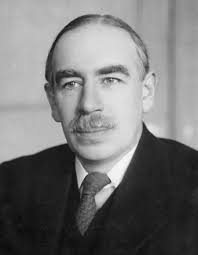
|
| Keynes |
Every newly-rich country seems to experience at least one episode of adolescent giddiness, thinking there is no stopping them, their trees will all grow to the sky. America's comeuppance took place in 1929, Japan's in 1990. Sooner or later the Chinese and the Indians will learn that it is unwise to grow faster than human systems can readjust, overcapacity is certain to appear at some point, and the new bumpkin will then appreciate what it means to have a business cycle. After a variable time, deflation reaches the bottom, and it is past time to inflate back to normal. Lord Keynes (pronounced "Caine's") advised Franklin Roosevelt to promote government spending, even useless spending, but it didn't help as much as they hoped. The Japanese built bridges and tunnels to nowhere, and that didn't help much either, although encouraging residential construction worked better than they expected. Wars are good for deflation, too, but only if you win them.
America has devised three methods for combating deflation: cutting taxes when other nations maintain fixed currencies, cutting consumer prices at the expense of developing countries, and cutting costs by improving productivity. You could combine these three methods into one principle: if you can't increase the amount of money, you must increase virtual spending power by cutting prices. In a deflation, consumer prices have fallen because of overcapacity, so you must cut consumer costs in those areas which will not respond to overcapacity. Same money, more buying power. Other countries are apt to resort to gold as a way of preserving their buying power; it will be an interesting struggle.
Nevertheless, it will be important for America to spend its affluence on increasing productivity rather than trinkets and junkets; we, too, have our share of adolescents. Computers have helped us reduce transactional costs everywhere; transportation is in fair shape. Education is an expensive mess, simply begging for improvement. Housing is still using 19th Century methods. Entertainment is expendable. We have a huge supply of underutilized labor in the black male community, in the early retirees, and in our comfortable work habits. Fighting wars is a pretty expensive hobby. How well we withstand the next world recession will depend to a major degree on how well we solve the problems that obviously need solving.
The business cycle will continue to cycle, but it is possible to feel pretty good about American ingenuity in relating, globalizing and enhancing productivity. There is even a wicked satisfaction in reminding our British cousins of their little witticism which made the rounds after World War II:
In Washington, Lord Halifax
Once whispered across to Lord Keynes:
"It's true that they have big moneybags,
But we have all of the brains."
Germantown and the French and Indian War
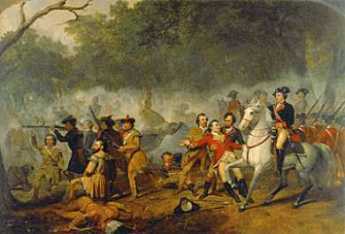
|
| The survivors of General Braddock's defeated army |
Allegheny Mountains from which to trade with, and possibly convert the Indians, the French had a rather elegant strategy for controlling the center of the continent. It involved urging their Indian allies to attack and harass the English-speaking settlements along the frontier, admittedly a nasty business. The survivors of General Braddock's defeated army at what is now Pittsburgh reported hearing screams for several days as the prisoners were burned at the stake. Rape, scalping and kidnapping children were standard practice, intended to intimidate the enemy. The combative Scotch-Irish settlers beyond the Susquehanna, which was then the frontier, were never terribly congenial with the pacifism of the Eastern Quaker-dominated legislature. The plain fact is, they rather liked to fight dirty, and gouging of eyes was almost their ultimate goal in any mortal dispute. They had an unattractive habit of inflicting what they called the "fishhook", involving thrusting fingers down an enemy's throat and tearing out his tonsils. As might be imagined, the English Quakers in Philadelphia and the German Quakers in Germantown were instinctively hesitant to take the side of every such white man in every dispute with any redone. For their part, the Scotch-Irish frontiersmen were infuriated at what they believed was an unwillingness of the sappy English Quaker-dominated legislature to come to their defense. Meanwhile, the French pushed Eastward across Pennsylvania, almost coming to the edge of Lancaster County before being repulsed and ultimately defeated by the British.
In December 1763, once the French and Iroquois were safely out of range, a group of settlers from Paxtang Township in Dauphin County attacked the peaceable local Conestoga Indian tribe and totally exterminated them. Fourteen Indian survivors took refuge in the Lancaster jail, but the Paxtang Boys searched them out and killed them, too. Then, they marched to Philadelphia to demand greater protection -- for the settlers. Benjamin Franklin was one of the leaders who came to meet them and promised that he would persuade the legislature to give frontiersmen greater representation, and would pay a bounty on Indian scalps.
Very little is usually mentioned about Franklin's personal role in provoking some of this warfare, especially the massacre of Braddock's troops. The Rosenbach Museum today contains an interesting record of his activities at the Conference of Albany. Isaac Norris wrote a daily diary on the unprinted side of his copy of Poor Richard's Almanac while accompanying Franklin and John Penn to the Albany meeting. He records that Franklin persuaded the Iroquois to sell all of western Pennsylvania to the Penn proprietors for a pittance. The Delaware tribe, who really owned the land, were infuriated and went on the warpath on the side of the French at Fort Duquesne. There may thus have been some justice in 1789 when the Penns were obliged to sell 21 million acres to the Commonwealth of Pennsylvania for a penny an acre.
Subsequently, Franklin became active in raising troops and serving as a soldier. He argued that thirteen divided colonies could not easily maintain a coordinated defense against the unified French strategy, and called upon the colonial meeting in Albany to propose a united confederation. The Albany Convention agreed with Franklin, but not a single suspicious colony ratified the plan, and Franklin was disgusted with them. Out of all this, Franklin emerged strongly anti-French, strongly pro-British, and not a little skeptical of colonial self-rule. Too little has been written about the agonizing self-doubt he must have experienced when all of these viewpoints had to be reversed in 1775, during the nine months between his public humiliation at Whitehall, and his sailing off to meet the Continental Congress. Furthermore, as leader of a political party in the Pennsylvania Legislature, he also became vexed by the tendency of the German Pennsylvanians to vote in harmony with the Philadelphia Quakers, and against the interest of the Scotch-Irish who were eventually the principal supporters of the Revolutionary War. It must here be noticed that Franklin's main competitor in the printing and publishing business was the Sower family in Germantown. Franklin persuaded a number of leading English non-Quakers that the Germans were a coarse and brutish lot, ignorant and illiterate. If they could be sent to English-speaking schools, perhaps they could gradually be won over to a different form of politics.
Since the Germans of Germantown was supremely proud of their intellectual attainments, they were infuriated by Franklin's school proposal. Their response was almost a classic episode of Quaker passive-aggressive warfare. They organized the Union School, just off Market Square. It was eventually to become Germantown Academy. Its instruction and curriculum were so outstanding as to justify the claim that it was the finest school in America at the time. Later on, George Washington would send his adopted son (Parke Custis) to school there. In 1958 the Academy moved to Fort Washington, but needless to say, the offensive idea of forcing the local "ignorant" Germans to go to a proper English school was rapidly shelved. This whole episode and the concept of "steely meekness" which it reflects might be mirrored in the Japanese response, two centuries later, to our nuclear attack. Without the slightest indication of reproach, the Japanese wordlessly achieved the reconstruction of Hiroshima as now the most beautiful city in the modern world.
Quakerism and the Industrial Revolution
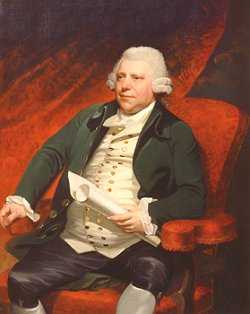
|
| Richard Arkwright |
The Industrial Revolution had a lot to do with manufacturing cotton cloth by religious dissenters in the neighborhood of Manchester, England in the Eighteenth Century. What needs more emphasis is the remarkable fact that Quakerism and the Industrial Revolution both originated about the same time, in about the same place. True, the industrializing transformation can be seen in England as early as 1650 and as late as 1880. The Industrial Revolution thus extended before Quakerism was even founded, as well as long after most Quakers had migrated to America. No Quaker names are much mentioned except perhaps for Barclay and Lloyd in banking and insurance, and Cadbury in candy. As far as local history in England's industrial midlands is concerned, the name mentioned most is Richard Arkwright, whose behavior, demeanor and beliefs were anything but Quaker.
He seems to have invented nothing, stealing the patents and ideas of others freely, while disgustingly boasting about his rise from rags to riches. Some would say his skill was in the organization, others would say he imposed an industrial dictatorship on a reluctant agricultural community. He grew rich by coercing orphans, convicts and others he obviously disdained into long, unpleasant, boring and unwelcome labor that largely benefited him, not them. In the course of his strivings, he probably forced Communism to be invented. It is no accident that Karl Marx wrote the Communist Manifesto while in Manchester visiting his friend Friedrich Engels, representing reasonably well the probable attitudes of Arkwright's employees. What Arkwright recognized and focused on was that enormous profits could flow from bringing piecework weaving into factories where machines could do most of the work. Until his time, clothing was mostly made by piecework at home, with middlemen bringing it all together. The trick was to make clothing cheaper by making a lot of it, and making a bigger profit from a lot of small profits. Since the main problem was that peasants intensely disliked indoor confinement around dangerous machines, the industrial revolution in the eyes of Arkwright and his ilk translated into devising ways to tame such semi-wild animals into submission. For their own good.
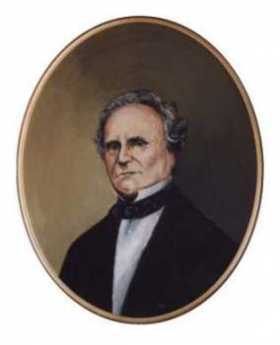
|
| Charles Babbage |
Distinctive among the numerous religious dissenters in the region, the Quakers taught that it was an enjoyable experience to sit indoors in quiet contemplation. Their children were taught to submit to it at an early age, and their elders frequently exclaimed that it was a blessing when everyone remained quiet, enjoying the silence. Out of the multitude of religious dissenters in the first half of the Seventeenth century, three main groups eventually emerged, the Quakers, the Presbyterians, and the Baptists. Only the Quakers taught that silence was productive and enjoyable; the Calvinist sects leaned toward the idea that sitting on hard English oak was good for the soul, training, and discipline was what kept 'em in line.
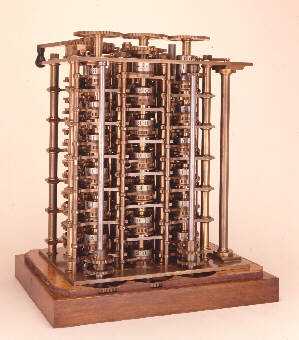
|
| babbagemaq.jpg |
The Quaker idea of fun through daydreaming was peculiarly suitable for the other important feature of the Industrial Revolution that Arkwright and his type were too money-centered to perceive. If workers in a factory were accustomed to sit for hours, thinking about their situation, someone among them was bound to imagine some small improvement to make life more bearable. If such a person was encouraged by example to stand up and announce his insight, eventually the better insights would be adopted for the benefit of all. Two centuries later, the Japanese would call this process one of continuous quality improvement from within the Virtuous Circle. In other cultures, academics now win professional esteem by discovering "win-win behavior", which displaces the zero-sum or win/lose route to success. The novel insight here was that it has become demonstrably possible to prosper without diminishing the prosperity of others. In addition, it was particularly fortunate that many Quaker inhabitants of the Manchester region happened to be watchmakers, or artisans of similar trades that easily evolved into the central facilitators of the new revolution -- becoming inventors, machine makers and engineers.
The power of this whole process was relentless, far from limited to cotton weaving. When Charles Babbage sufficiently contemplated the punched-cards carrying the simple instructions of the knitting machines, he made an intellectual leap to the underlying concept of the tabulating machine. Using what was later called IBM cards, he had the forerunner of the stored-program computer. There were plenty of Arkwrights getting rich in the meantime, and plenty of Marxists stirring up rebellion with the slogan that behind every great fortune is a great crime. But the quiet folk were steadily pushing ahead, relentlessly refining the industrial process through a belief in welcoming the suggestions of everyone.
Ageing Owners, Ageing Property
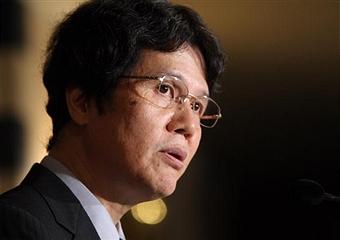
|
| Kiyohiko Nishimura |
Kiyohiko Nishimura is currently the Deputy Governor of the Bank of Japan (BOJ), and as such is expected to have wise things to say about finances, as indeed he does. Japan has a far older culture than the United States, and a botanical uniqueness growing out of the glaciers avoiding it, many thousands of years ago. But its latitude is approximately the same as ours, and its modern culture is affected by the deliberate effort of the Emperor to westernize the nation, following its "opening up" by our own Commodore Matthew Perry in 1852. Perhaps a more important relationship between the two cultures for present purposes is that Japan has been suffering from the current deep recession for fourteen years longer than we have. We don't want to repeat that performance, but we can certainly learn from it.
Mr. Nishimura lays great stress on the aging of the Japanese population because, in all nations, houses are mainly purchased by young newly-weds, and sold by that same generation years later as they prepare to retire. If a nation has an elderly population, it can expect a general lowering of house prices someday, reflecting too many sellers leaving the market at the same time. The buyers of those houses are competing with other young people, so the simultaneous bulges and dips of the population at later stages combine to have major effects on housing prices. At the moment, younger couples are having fewer children as a result of women postponing the first one. Nishimura goes on to reflect that something like the same is true of stocks and bonds, although at age levels five or ten years later. One implication is that retirement of our own World War II baby boom is about to depress American home prices, which will likely stay lower for 10-20 more years. Furthermore, our stock market will have a similar effect, stretching the depression out by as much as 5-15 years. The Japanese stock market has been a gloomy place to be during the past fifteen years, and by these lights might continue in the doldrums for another five or so. Meanwhile, our own situation predicts an additional generation of struggle while Japan is recovering. It's best not to apply these ideas too closely, of course, but surely somebody in our government ought to dig around in the data, at least telling us why we ain't goin' to repeat this pattern. Please.
Perhaps because they eat so much rice and fish, the Japanese already have a longer life expectancy than Americans do, but in terms of outliving your assets, that's not wholly advantageous, the way a love of golf might be. The best our nation might be able to do is to examine some of our premises about housing construction. In Kyoto, most houses were built with paper walls, for example.
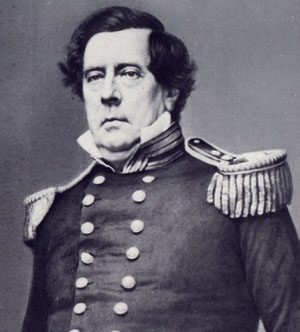
|
| Commodore Matthew Perry and Japan |
The house walls of the town of Kyoto were in fact made of waxed paper, which seems to work remarkably well. While no one now advocates going quite that far, we might think a second time about building the big hulking masonry houses so favored in our affluent suburbs. Such cumbersome building materials almost dictate custom building and strongly discourage mass production. How likely are such fortresses to survive in the real estate markets of fifty years from now? Judging from my home town, not too well. Haddonfield boasts it has been around since 1701, and there are at most three or four of its houses which have survived that long. We favor great hulking Victorian frame houses, with a good many bedrooms unoccupied, and high drafty ceilings, very large window openings and little original insulation. The heating arrangements have gone from fireplaces to coal furnaces, to oil, and lately to natural gas. The meter reader who checks my consumption every month tells me that almost all the houses now have gas heat, so almost all the houses are using their second or third heating plant, along with their eighth or tenth roof, and thirty coats of paint. This kind of maintenance is not prohibitively expensive, but just wait until the plumbing starts to go, and leak, and freeze, with attendant plastering, carpentry, and painting. Our schools and transportation are excellent, so we have location, location, location. But when the plumbing, heating, and roofing start to require financial infusions all at once, you get tear-downs. A tear-down is a new house in which a specialist builder buys the old house, tears it down, and looks for a buyer to commission the new house on an old plot of land. Right now, there appear to be six or eight such Haddonfield houses, torn down and looking for a buyer to commission a new house on that location, location. If we repeat the Japanese experience, there will be some unhappy people, somewhere. And that will include the neighbors like me, who generally do not relish languishing vacant lots next door, but fear what the new one will be like.
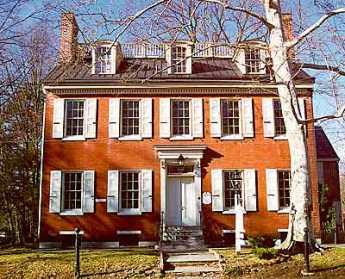
|
| Greenfield Hall |
The thought has to occur to somebody that building the whole town of less substantial materials in the first place would be worth investigation, replacing the houses every forty years when the major stuff wears out. At the present, when a town of several thousand houses has five or six tear-downs, the neighbors would not tolerate replacing tear-downs with insubstantial cardboard boxes. Seeing what has happened to inner-city school systems, the neighbors would be uneasy about "affordable housing" built in place of stately old Homes of Pride. In time, that might lead to a deterioration of one of the two pillars of location, location -- the schools -- and hence to a massive loss of asset value. And yet when those houses empty out the school children, leaving only retirees in place, the schools will not be worth much to the owners or in time to anybody else. There's an unfortunate tendency for local political control to migrate into the hands of local real estate brokers, so you had better be sure any bright new proposal is tightly buttressed with facts.
The only real hope for evolution in this obsolete system may lie in the schools of architecture, strengthened perhaps by some research grants. Countless World Fairs have displayed the proud products of their imaginative thinking, but mostly to no avail. Perhaps the ideas are not yet ripe, but since it would take more than a generation to create a useful demonstration project of whatever does become ripe for decision, let's start thinking about some innovative suburban designs, right now.
13 Blogs
Madame Butterfly (2)
 It is Puccini's genius to take this story of two nasty Americans destroying an honorable Japanese girl, and using the same story with the same words, make it into a romantic woman destroyed by a hopeless, helpless love affair. /br>
It is Puccini's genius to take this story of two nasty Americans destroying an honorable Japanese girl, and using the same story with the same words, make it into a romantic woman destroyed by a hopeless, helpless love affair. /br>
Emperor's Doctor
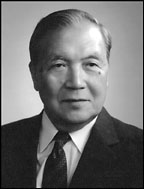 Almost trapped by the events at Pearl Harbor of which he had advance knowledge, this Pennsylvania Hospital intern rose to the top of Japanese medicine.
Almost trapped by the events at Pearl Harbor of which he had advance knowledge, this Pennsylvania Hospital intern rose to the top of Japanese medicine.
Philadelphia and Japan
 Sea faring Philadelphia was early in the opening of Japan. There is a long history of affection with the Japanese and their culture, possibly related to the understated architecture and dress, and the strong code of honor.
Sea faring Philadelphia was early in the opening of Japan. There is a long history of affection with the Japanese and their culture, possibly related to the understated architecture and dress, and the strong code of honor.
Inflating and Deflating Japan.
 Shifty financial winds rattle any boat, then panic at the helm can capsize it. Just look at Japan.
Shifty financial winds rattle any boat, then panic at the helm can capsize it. Just look at Japan.
Inazo Nitobe, Quaker Samurai
 One of the most revered leaders of modern Japan was a converted Samurai, married to a Philadelphia Quaker. His father was an advisor to the Emperor, a family of famous warriors.
One of the most revered leaders of modern Japan was a converted Samurai, married to a Philadelphia Quaker. His father was an advisor to the Emperor, a family of famous warriors.
AFSC: American Friends Service Committee
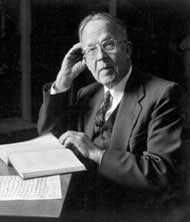 Quakers serve, without fear or favor.
Quakers serve, without fear or favor.
Philadelphia in 1876: The Centennial
 A hundred years after the Declaration, Philadelphia announced to the world that is was here. And Philadelphia learned there was a lot out there in the rest of the world.
A hundred years after the Declaration, Philadelphia announced to the world that is was here. And Philadelphia learned there was a lot out there in the rest of the world.
West Fairmount Park
 Fairmount Park, west of the river, is the largest part. The 1876 Centennial was held there.
Fairmount Park, west of the river, is the largest part. The 1876 Centennial was held there.
Paying Bills Electronically
 Here are four suggestions for improving electronic bill paying.
Here are four suggestions for improving electronic bill paying.
Making Money (5)
 The business cycle has not been repealed. Other countries are likely to drag us into the next world recession, and we had better be thinking ahead.
The business cycle has not been repealed. Other countries are likely to drag us into the next world recession, and we had better be thinking ahead.
Germantown and the French and Indian War
 In 1750, the frontier was not very far from Germantown, and the pacifist Germans were as conflicted as English Quakers about Scotch-Irish behavior, Indian warfare techniques, and Benjamin Franklin
In 1750, the frontier was not very far from Germantown, and the pacifist Germans were as conflicted as English Quakers about Scotch-Irish behavior, Indian warfare techniques, and Benjamin Franklin
Quakerism and the Industrial Revolution
 The Industrial Revolution extended over two centuries and was more important than all the wars, governments, and agitations of its time. Quakerism began at the same time, in the same place. Was that only coincidence?.
The Industrial Revolution extended over two centuries and was more important than all the wars, governments, and agitations of its time. Quakerism began at the same time, in the same place. Was that only coincidence?.
Ageing Owners, Ageing Property
 From Japan, we get a fresh view of our assets. Kiyohiko Nishimura observes that the price of a house, even of a stock portfolio, has something to do with the age of the owner who is selling it.
From Japan, we get a fresh view of our assets. Kiyohiko Nishimura observes that the price of a house, even of a stock portfolio, has something to do with the age of the owner who is selling it.